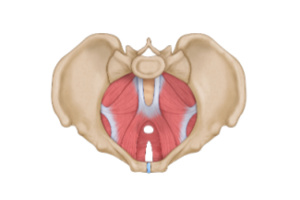Women’s bodies are designed to adapt to support childbirth, but not all of the changes that occur during this time are welcome. For some women, pregnancy and childbirth can leave their pelvic floor muscles either too weak or too tight, both of which can cause pain and other issues.
Here is a closer look at what happens to the pelvic floor after childbirth and how you can restore function and relieve pain in this area.
What Is The Pelvic Floor?

The pelvic floor is made up of connective tissue and muscles that support the organs found in your pelvis, such as your bladder, intestines, rectum, urethra, uterus, vagina, and cervix. These muscles are crucial for daily functions, and they also contribute to your sexual health and play a role in arousal and orgasms. In addition, they are also responsible for stabilizing your trunk and hips, particularly when you are standing or walking.
What Happens To Your Pelvic Floor In Childbirth?
It is normal for your pelvic floor muscles to stretch and weaken during pregnancy and birth. In fact, your body is designed to adapt in this way to enable the baby to pass through the vagina. However, this can cause several problems, including:
Pelvic Organ Prolapse
Pelvic organ prolapse occurs when the pelvic organs start to descend into the vagina or push down on it due to a weak pelvic floor. It may feel like something is falling out of the vagina or is simply not in the right place. This could occur only while making certain movements, or it may be a sensation that you feel all the time. It can also cause a sense of heaviness or a dragging sensation.
Although this can be very alarming, most women can resolve it by avoiding heavy lifting, losing weight, and performing pelvic floor exercises regularly, typically under the care of a pelvic floor physical therapist.
Stress Incontinence

Although leaking urine while laughing, coughing, or sneezing can be a source of great embarrassment, it is extremely common in new moms and can usually be treated easily via pelvic floor exercises, known as Kegels. Physical therapy can help restore proper tone to the pelvic floor, allowing women to regain control over their bladder and bowel and increasing their pleasure during sex.
Frequent Urination
Some pelvic floor problems can lead to frequent urination, whether it comes in the form of a constant need to use the bathroom, frequent night awakenings to urinate, or an obsessive need to use the bathroom before leaving the house.
Incomplete emptying, or the sensation that you still need to urinate even after you have just emptied your bladder, is another common childbirth-related pelvic floor problem, as is feeling the strong need to urinate but being unable to do so.
Pelvic, Back, or Hip Pain
After childbirth, some women may feel constant or intermittent pain in their pubic bone or in the pelvic region in general. Some women will only notice pain during sexual penetration or while inserting tampons. Many times, this pain can be traced to changes in the pelvic floor after childbirth.
Although you may not make the connection immediately, pelvic floor issues related to childbirth can also lead to lower back or hip pain.
How Can Postpartum Pelvic Floor Issues Be Resolved?
Although you may have heard of women having surgery for pelvic floor issues, it may be comforting to know that these problems can often be solved with pelvic floor exercises that you can carry out on your own or under the guidance of a pelvic floor therapist.
What Does Pelvic Floor Therapy Entail?
A pelvic floor therapist will work with you to determine what could be causing your issues. You’ll be asked to describe what is wrong, and they will also make a physical assessment to get a better idea of what may be causing these problems so they can devise the best approach to correct them.

You will be given an individualized exercise program and instructed on the proper form to use for each movement. This will often include Kegels, the pelvic floor strengthening exercises, particularly if you are experiencing incontinence or prolapse. Although some women are familiar with these exercises, physical therapists have warned that many are performing them incorrectly, which can lead to further damage. Your therapist can show you the right way to perform Kegels and tell you how often you should do them at home.
They might also use approaches such as biofeedback, massage, and other exercises for posture, strength, and flexibility.
Pelvic floor physical therapy can correct many childbirth-related issues within a few months, although the precise length of treatment depends on the type and severity of the problem.
Get In Touch With The Women’s Healthcare Team
If you are concerned about any of the changes you have experienced after giving birth, make an appointment with the experienced women’s healthcare professionals at Raleigh Gynecology & Wellness today.
